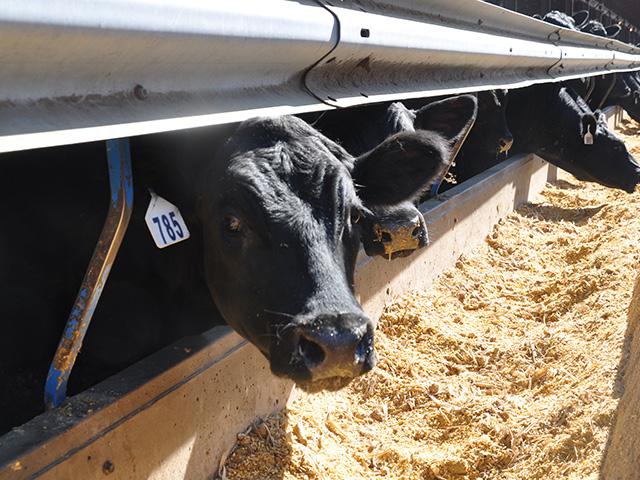USDA Reporting Cattle Sold on Formulas
USDA Creating New Cattle Price Reports Tied to Formula Contracts
OMAHA (DTN) -- USDA on Thursday announced that its USDA Market News on Monday, Aug. 9, will begin releasing price reports based on cattle sold on formulas, grids and contracts.
The changes in reports come as USDA has been focusing on concentration in livestock markets and looking for ways to provide more price discovery beyond daily reported negotiated cash trade. Cattle markets have been the subject of congressional hearings in recent weeks, and lawmakers have been calling for the Department of Justice to release the results of an investigation into cattle markets and beef prices during spring of 2020 as the pandemic affected the supply chain.
USDA will release a new National Daily Direct Formula Base Cattle report looking at the correlation between negotiated cash trade and reported formula-based prices, as well as the aggregated values being paid as premiums and discounts. Daily formula base price reports will be national in scope and released in morning, summary and afternoon versions, USDA stated. That report will start on Monday. The weekly and monthly formula base reports will be both national and regional in scope and include forward contract base purchase information, USDA stated.
Along with that, USDA will also begin a National Weekly Cattle Net Price Distribution report that will show at what levels (price and volume) trade occurred across the weekly weighted average price for each purchase type -- negotiated, negotiated grid, formula and forward contract. Currently, the market speculates whether large or small volumes of cattle trade on both sides of the price spread. And, in fact, with premiums and discounts applied to the prices, the spreads shown on reports can be wide. Publishing a price distribution for all cattle net prices will offer more transparency to each of the purchase-type categories. This report is a window into what producers are paid for cattle (net) and retains confidentiality by segregating volumes purchased in $2 increments plus/minus the daily weighted average price, depending upon premiums and discounts. AMS has published a similar net price distribution report for direct hogs since January 2010.
U.S. Agriculture Secretary Tom Vilsack noted in a statement that negotiated cash trade has dropped roughly 30% below the volume of 2005 while formula contracts have increased at about the same rate.
P[L1] D[0x0] M[300x250] OOP[F] ADUNIT[] T[]
"Our new reports on formula transactions will bring needed clarity to the marketplace." Vilsack said. "Also, in the coming months, we plan to conduct several producer-focused outreach sessions to help producers and others understand how these data can inform real-world marketing decisions at farm, ranch, feedlot and other points in the supply chain."
USDA is using data from its Livestock Mandatory Price Reporting law. Livestock groups have been calling on USDA to adjust its price reporting. They also have asked Congress to complete legislation to reauthorize the price-reporting law.
The National Cattlemen's Beef Association and the U.S. Cattlemen's Association both credited USDA with making the price-reporting changes, and each group highlighted that they had requested USDA make those changes.
"USDA's announcement is a significant step toward increasing transparency in the cattle markets," said Ethan Lane, vice president of government affairs at NCBA. "As Livestock Mandatory Reporting awaits congressional reauthorization, it is encouraging to see the administration taking proactive steps to broaden the scope of this critical information tool. NCBA remains committed to maximizing market transparency and looks forward to building on this momentum to shed more light on the fed cattle trade."
Brooke Miller, president of the U.S. Cattlemen's Association, said the publication of additional market information will help fulfill USDA's efforts to promote competition, as outlined in President Joe Biden's executive order last month.
"USCA appreciates the swift review and prompt follow-up of USDA Agricultural Marketing Service leadership and staff in response to USCA's letter," Miller said. "USCA looks forward to working with USDA leadership to continue identifying areas where we can work towards the goal of fair and competitive markets."
Sen. Roger Marshall, R-Kan., also credited USDA for making the price-reporting changes and said he had talked several times with USDA leadership on price transparency and cattle markets.
"I've had several conversations with the USDA asking for more meaningful information within the formula reporting bucket so Kansas cattle producers can make informed business decisions," Marshall said. "I applaud USDA for making this information available to the public and will continue to work with Department leadership to help make markets more transparent."
Last month, USDA also announced $500 million will become available to help expand meat and poultry processing. The department currently is requesting information about how to spend that money. USDA also is working to rewrite at least three rules in the Packers & Stockyards Act regarding competitive behavior as well.
Starting Monday, producers should be able to find the formula-based reports here: https://www.ams.usda.gov/….
Chris Clayton can be reached at Chris.Clayton@dtn.com
Follow him on Twitter @ChrisClaytonDTN
(c) Copyright 2021 DTN, LLC. All rights reserved.




